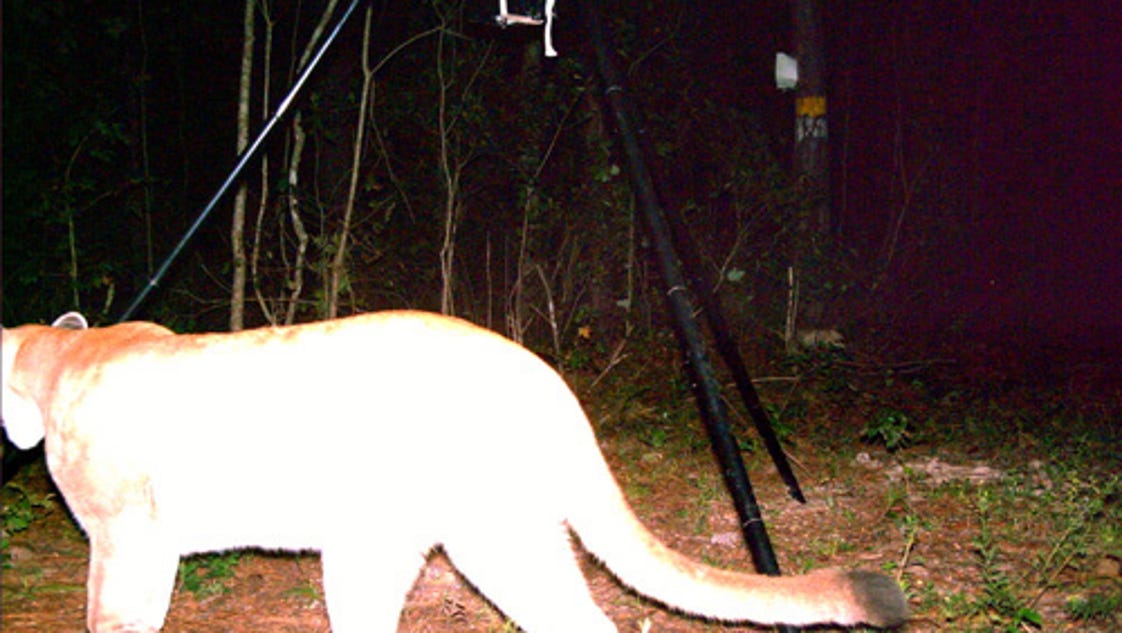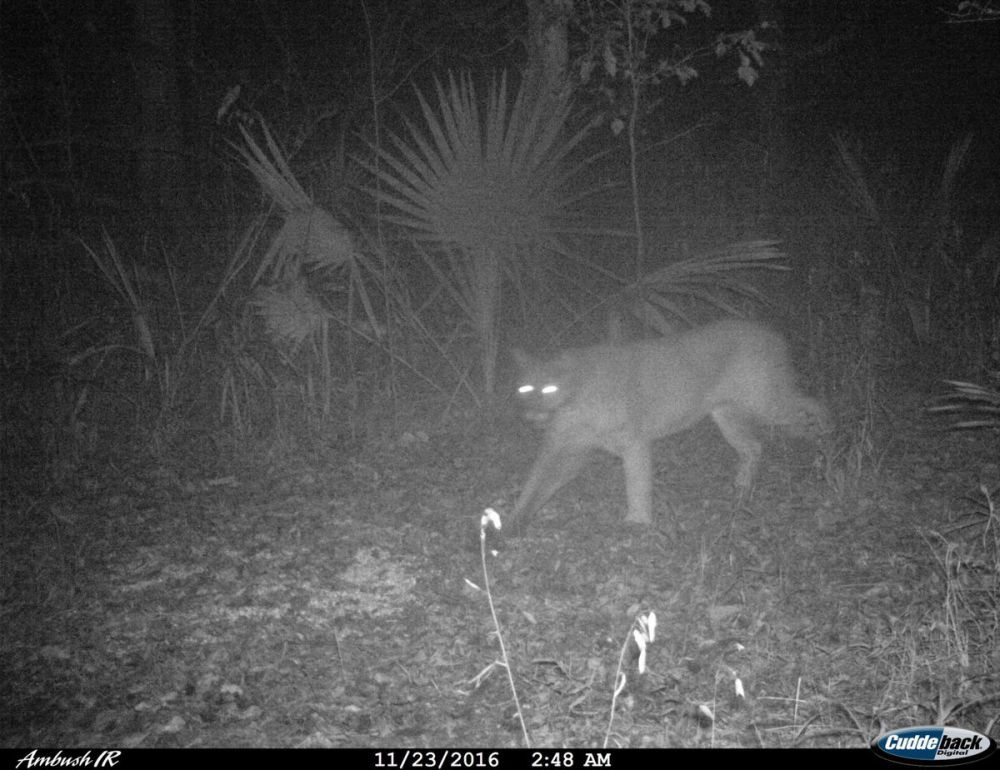- Thread starter
- #1
Pokes-WalkingBoss
Well-Known Member
Wildlife & Fisheries confirms cougar sighting in Northeast Louisiana

Print Email
 By Todd Masson, NOLA.com | The Times-Picayune The Times-Picayune
By Todd Masson, NOLA.com | The Times-Picayune The Times-Picayune
Follow on Twitter
on December 21, 2016 at 6:54 AM, updated December 21, 2016 at 6:58am
For years, Louisiana residents who reported cougar sightings were considered just barely a notch above those who shared morning coffee with extraterrestrial visitors on flying saucers. But another confirmed cougar sighting late last month indicates the big cats make at least occasional forays into the Bayou State.
A Louisiana Department of Wildlife and Fisheries biologist conducted a site investigation, and determined a trail-camera photo submitted to the agency was legitimate. The sighting occurred in Northeast Louisiana.
Maria Davidson, manager of the department's Large Carnivore Program, said area hunters should be on the lookout for the cougar.
"It is quite possible this animal could be photographed on other trail cameras placed at deer feeders," she said. "It is unlikely this cougar will remain in any one area longer than it would take to consume a kill. It is impossible to determine if the animal in the photograph is a wild, free-ranging cougar or an escaped captive."
Owning cougars is illegal in Louisiana, but it's possible the one in Northeast Louisiana got out of a pen or cage.
The recent sighting is one of several documented by the department in recent years.
The first was in 2002 by an employee of Lake Fausse Point State Park. It was later confirmed with DNA analysis from scat found at the site.
Three confirmed trail-camera photos were taken of a cougar in Allen, Vernon and Winn parishes in 2008.
A cougar was shot and killed in a neighborhood by the Bossier City Police Department on Nov. 30, 2008. The DNA from that cougar confirmed it originated from a New Mexico population.
Another confirmed trail-camera picture was submitted in August of 2011 from Vernon Parish. There have been no additional reports since then until the recent sighting.
The mountain lion, cougar, panther or puma are all names that refer to the same animal. Its color ranges from light tan to brownish grey. The only species of big cats that occur as black are the jaguar and leopard. Jaguars are native to South America and leopards to Africa. Both species can occur as spotted or black, although in both cases the spotted variety is much more common.
Although the department has received many calls about black panthers, there has never been a documented case of a black cougar anywhere in North America.
The department said it receives calls reporting sightings of cougars throughout Louisiana. Many of the calls are found to be cases of mistaken identity, with dog tracks making up the majority of the evidence submitted by those reporting cougar sightings. Other animals commonly mistaken for cougars are bobcats and house cats, usually seen from a distance or in varying shades of light.
Because of the lack of physical evidence, the agency has concluded Louisiana does not have an established, breeding population of cougars. In states that have verified small populations of cougars, physical evidence can readily be found in the form of tracks, cached deer kills, scat and road kill.
The recent sightings of cougars in Louisiana are likely animals dispersing from existing populations. An expanding population in Texas can produce dispersing individual cougars that move into suitable habitat in Louisiana. Young males are known to disperse from their birthplace and travel hundreds of miles, seeking their own territories.
Penalties for killing a cougar in Louisiana may include up to one year in jail and a $100,000 fine. Anyone with any information regarding the killing of a cougar may call Operation Game Thief at 1-800-442-2511. Callers can remain anonymous and may receive a cash reward.
To report sightings of cougars with physical evidence such as photos, tracks or scat, contact Maria Davidson at 337-262-2080 or [email protected].


Print Email
Follow on Twitter
on December 21, 2016 at 6:54 AM, updated December 21, 2016 at 6:58am
For years, Louisiana residents who reported cougar sightings were considered just barely a notch above those who shared morning coffee with extraterrestrial visitors on flying saucers. But another confirmed cougar sighting late last month indicates the big cats make at least occasional forays into the Bayou State.
A Louisiana Department of Wildlife and Fisheries biologist conducted a site investigation, and determined a trail-camera photo submitted to the agency was legitimate. The sighting occurred in Northeast Louisiana.
Maria Davidson, manager of the department's Large Carnivore Program, said area hunters should be on the lookout for the cougar.
"It is quite possible this animal could be photographed on other trail cameras placed at deer feeders," she said. "It is unlikely this cougar will remain in any one area longer than it would take to consume a kill. It is impossible to determine if the animal in the photograph is a wild, free-ranging cougar or an escaped captive."
Owning cougars is illegal in Louisiana, but it's possible the one in Northeast Louisiana got out of a pen or cage.
The recent sighting is one of several documented by the department in recent years.
The first was in 2002 by an employee of Lake Fausse Point State Park. It was later confirmed with DNA analysis from scat found at the site.
Three confirmed trail-camera photos were taken of a cougar in Allen, Vernon and Winn parishes in 2008.
A cougar was shot and killed in a neighborhood by the Bossier City Police Department on Nov. 30, 2008. The DNA from that cougar confirmed it originated from a New Mexico population.
Another confirmed trail-camera picture was submitted in August of 2011 from Vernon Parish. There have been no additional reports since then until the recent sighting.
The mountain lion, cougar, panther or puma are all names that refer to the same animal. Its color ranges from light tan to brownish grey. The only species of big cats that occur as black are the jaguar and leopard. Jaguars are native to South America and leopards to Africa. Both species can occur as spotted or black, although in both cases the spotted variety is much more common.
Although the department has received many calls about black panthers, there has never been a documented case of a black cougar anywhere in North America.
The department said it receives calls reporting sightings of cougars throughout Louisiana. Many of the calls are found to be cases of mistaken identity, with dog tracks making up the majority of the evidence submitted by those reporting cougar sightings. Other animals commonly mistaken for cougars are bobcats and house cats, usually seen from a distance or in varying shades of light.
Because of the lack of physical evidence, the agency has concluded Louisiana does not have an established, breeding population of cougars. In states that have verified small populations of cougars, physical evidence can readily be found in the form of tracks, cached deer kills, scat and road kill.
The recent sightings of cougars in Louisiana are likely animals dispersing from existing populations. An expanding population in Texas can produce dispersing individual cougars that move into suitable habitat in Louisiana. Young males are known to disperse from their birthplace and travel hundreds of miles, seeking their own territories.
Penalties for killing a cougar in Louisiana may include up to one year in jail and a $100,000 fine. Anyone with any information regarding the killing of a cougar may call Operation Game Thief at 1-800-442-2511. Callers can remain anonymous and may receive a cash reward.
To report sightings of cougars with physical evidence such as photos, tracks or scat, contact Maria Davidson at 337-262-2080 or [email protected].














